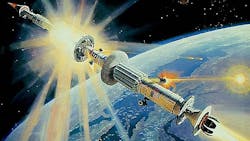Democratic House will have a major influence on U.S. military spending; may kill Space Force
THE MIL & AERO COMMENTARY – U.S. military spending, which only a few months ago looked like it would remain historically high for perhaps the next six years, or even longer, may take a sharp turn next month when the new Congress is seated.
That's when the House leadership turns over to the Democratic party, leaving Congress split between a pro-military Republican Senate and a Democratic House that's likely to turn its focus toward non-defense domestic programs.
Probably the most immediate result of the November congressional election will be the much-talked-about U.S. Space Force; it's likely dead, to put it bluntly. Creating a whole new U.S. military service, with its costly reorganizations and program shifts just isn't in the cards in a year when the larger of the two chambers of Congress just won't support it.
The initiative to create a Space Force has been on shaky ground from the beginning. Top leaders in the Pentagon were tepid on creating a new service branch; it really wasn't on their radar until President Trump proposed it early in his first term.
Related: Prospects dim in Congress for creation of Space Force as a new U.S. military branch
The Space Force never had a solid constituency to begin with. Individual presidents are temporary, serving only for four or eight years. It would take more than that to get a Space Force started. Now with an incoming Democratic House representatives, whose leaders have pledged to fight creation of a Space Force, was the final nail in the coffin.
A Space Force, were it to happen, would have control over military operations in space. It most likely would absorb Air Force Space Command, the Army's 1st Space Brigade, and the Navy's Space and Naval Warfare Systems Command and Naval Satellite Operations Center. The National Reconnaissance Office eventually would join.
Space Force missions would include space situational advantage; command and control of space forces; space lift and range operations; space support to nuclear command and control; missile warning; satellite communications; and position, navigation and timing (PNT).
There are a few reasons for creating a Space Force. First, responsibility for space acquisitions today is fragmented between about 60 organizations in the Department of Defense (DOD) and intelligence community.
Second, space personnel are scattered across the military and intelligence community, with too few people to create a viable career track for space professionals. Finally, the Army, Marine Corps, Navy, Air Force, and Coast Guard all focus on their own domains, and consider space as a secondary support function. Creation of a Space Force would consolidate missions and budgets, and give critical mass to U.S. military space missions.
Just as important, however, is what a new Space Force might do to the existing military services -- particularly to the Air Force, which has taken on the lion's share of U.S. military space missions. Without space, the Air Force might become too small of a service, which could trigger future military reorganizations, with all the money, time, and headaches that come with that.
It's hard to tell how a Democratic-led House might influence military budgets and missions in the near future. Established expensive programs like the F-35 joint strike fighter could be scaled back beyond where top military leaders want it. It will represent a bigger fight in Congress, that's for sure. Nuclear modernization also may be slowed.
There will be resistance in Congress to continued large military budgets. This will come at a time when military leaders are establishing new national defense priorities that include new generations of hypersonic weapons, laser weapons, and perhaps a new air-superiority jet fighter.
How it will shake out is anyone's guess.
Ready to make a purchase? Search the Military & Aerospace Electronics Buyer's Guide for companies, new products, press releases, and videos

